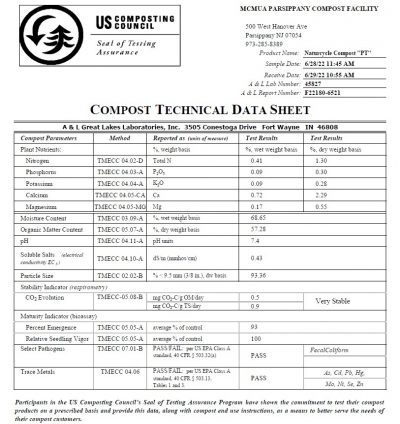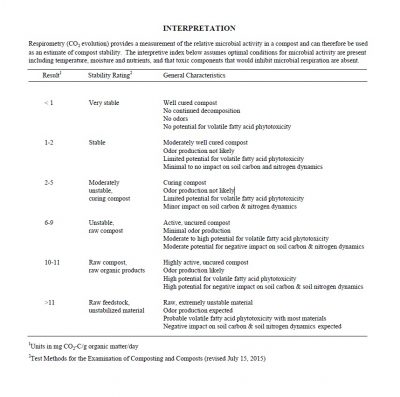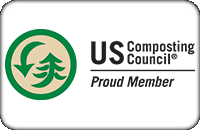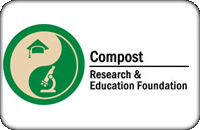Interpreting STA Data with a Compost Technical Data Sheet
Whether it is used in green roof media, erosion control blankets or wetland recovery, compost is a critical tool for stormwater management and restoring natural ecosystems. As examined in Part One and Part Two of this series, the Seal of Testing Assurance (STA) Program analyzes compost characteristics, while the Compost Analysis Proficiency (CAP) Program ensures that this information is high quality and reproducible. To use compost appropriately for a given application, it is vital to interpret this data correctly.
For every compost sample submitted to a testing laboratory through the STA program, a participating compost manufacturer receives two reports: a comprehensive analysis of all parameters tested, plus a Compost Technical Data Sheet (CTDS), such as the one shown below. Because the CTDS formats the compost data in the same way regardless of the laboratory that conducted the analysis, a compost user can directly compare either two different composts or the same compost at different points in time, using a simple, one-page report. While anyone can have compost tested to STA standards, only STA participants can receive a CTDS.
The data starts in the top right of the page, with the name and location of the compost facility, plus the Product I.D., which is the brand name of the compost. Next are the dates the compost was sampled from the site and received by the laboratory, followed by information about the laboratory, including the lab name, number, and address, as well as the associated report number for the completed analysis. Finally, the results of the compost testing are presented, along with the standardized methods and units of measure.
Plant Nutrients
Nitrogen, phosphorous, potassium, calcium, and magnesium, often referred to as macronutrients, are critical elements for plant growth. Their concentration in a compost product is used to calculate application rates for agronomic purposes. Unlike chemical fertilizer, using compost as a soil amendment provides organic forms of these nutrients rather than a manufactured form, the nutrients are released to plants more slowly, over a longer period of time. The wet weight basis refers to the concentration of nutrients in the compost as it was received by the lab, with whatever naturally occurring moisture that is present, while the dry weight basis is based on a calculation that removes the water weight of the sample. (Some states do not allow producers to indicate the nutrient content of their compost, so the CTDS includes a second page that omits this information but is otherwise identical.)
Moisture Content
Moisture content refers to the percentage of the sample weight that is made up of water at the time of testing. This number can vary seasonally or due to material handling. A moisture content of 30% to 55% is common for most compost types and textures, but values slightly outside this range would not impact most uses. Consistent moisture content over 65% indicates a lower quality compost product and a flawed manufacturing process.
Organic Matter Content
Organic matter content is a measure of the organic carbon compounds in a compost sample and is expressed by a percentage of total mass. A critical component for amending soil, organic matter content improves soil health and supports plant growth, and optimally falls into a range of 30% to 60% for a high-quality compost. Findings in the 15% to 30% range may indicate an older compost where much of the organic matter has been mineralized, resulting in a less effective soil amendment, while organic matter content over 60% indicates excessive nutrient content that can produce a toxic effect in the soil.
pH
pH is a measure of free hydrogen ions in a compost sample, which assists the nutrient uptake in plants. A pH in the range of 6 to 8 is a good target for a wide variety of compost applications. A finished and stabilized compost is often slightly alkaline, with a pH over 7, particularly in the northeastern United States where deciduous leaves make up a significant portion of many compost products. Ultimately, local environmental conditions play a much larger role in determining the pH of an amended soil than the pH of the compost used to amend it.
Soluble Salts
The concentration of soluble salts in a compost sample is a measure of electrical conductivity resulting from dissolved inorganic solutes. Common soluble salts include calcium, magnesium, chloride, sulfate, and smaller quantities of ammonium nitrate or other potential plant nutrients. As part of the STA methodology, soluble salts are measured in a 5:1 dilution of distilled water to compost media based on the peer reviewed TMECC standards, but results can vary between laboratories. While an optimal range between 0.5 to 2.0 dS/m (or mmhos) can be considered, this measure can vary widely. Some soluble salts are harmful to plants while other are beneficial, so further examination may be needed on a compost with higher readings. Composts with low levels of soluble salts can be beneficial for certain uses, but composts with zero soluble salts indicate that there are few or no available plant nutrients.
Particle Size
This parameter is a physical measure of the compost, where the material is passed through sieves that range in size. The CTDS reports the portion of compost that passes the 3/8” inch sieve (9.5 millimeters). The complete STA Compost Analysis reports more detailed results within a range sieve sizes. Particle size is an important consideration, especially for erosion control projects where larger particle sizes are more desirable.
Compost Stability
In the STA program, CO2 evolution is a measure of compost stability. The TMECC standard methodology calls for testing this parameter via respirometry, which measures the metabolic rate of the active biology in the compost and assigns a Stability Rating. In this case, lower numerical values are better, with a result at or below 2.0 being considered a stable or very stable compost. A result over 2.0 suggests that the tested material may still be actively composting and is therefore considered unstable. A detailed summary for compost stability from Penn State follows:
Compost Maturity
The STA program requires a bioassay to be performed using submitted compost samples. This is a unique test that measures the compost by its effect on living cells or tissues, in this case, cucumber seedlings, which are relatively easy to grow and have a well-defined leaf structure useful for comparison. Conducted in a growth chamber controlled for temperature, moisture, and light, the compost is diluted 50/50 with vermiculite and compared to a high-quality potting mix used as a control. While this dilution has a higher concentration of compost than a typical compost use, it serves to accentuate the effects of the compost in this experimental setup.
Percent emergence measures the number of cucumber seeds that germinate in the compost sample compared to the control sample using the same seeds. A result above 80% is considered mature. Relative seedling vigor is a visual comparison of the physical structure and appearance seedlings grown in compost to those grown in the control media. The plants growing in compost must be taller and have larger leaves to achieve a higher percentage result. This test is one of the most useful, where phytotoxic effects can be observed, such as curled leaves or underdevelopment. These combined tests provide a great deal of information for compost producers and end users.
Select Pathogens
The STA program requires participants to test for either fecal coliform or salmonella, two common pathogens that the U.S. Environmental Protection Agency (EPA) considers to be main indicators for human health and safety. This parameter is measured using the Most Probable Number (MPN) index, which is defined as:
“an index of the number of bacteria that more probably than any other number would give the results shown by laboratory examination, the results of which are not an actual enumeration but are taken from standardized probability tables.”
Like the EPA regulatory limits for biosolids, the STA considers 1,000 MPN to be the limit for compost. Samples exceeding this value are deemed to fail pathogen testing while samples with an MPN below this value are deemed to pass. It is worth noting that naturally occurring background levels of these pathogens in soils is many times higher than the standard for compost. When completed correctly, the composting process reduces pathogens, so using this indicator confirms that the compost was produced properly and the likelihood of passing dangerous pathogens in a compost is extremely low, if not eliminated.
Trace Metals
Another special requirement of the STA program is the regular testing of heavy metals that can impact human health. Once again using the EPA regulatory limits for biosolids, the STA program sets a maximum allowable concentration of heavy metals that can appear in compost on an average annual basis. All heavy metals must fall below these limits for a compost to pass heavy metals testing. If any one of the metals tested exceeds their limit, the compost sample fails. A typical compost will have heavy metals well below these limits and may not appear in detectable amounts at all.
End Use Instructions
Since the STA is both a testing program and a disclosure program, every participant to provide end use instructions and list the ingredients used to make their compost, emphasized by the notation at the bottom of the CTDS. As an STA participant, Naturcycle provides end use instruction for every compost that we market as well as guidance on application rates.
This is only a brief summary of the Compost Technical Data Sheet and the tremendous amount of data contained therein. The upcoming Part Four of this series will focus on how Naturcycle uses this compost data to design specifications. Stay tuned!







